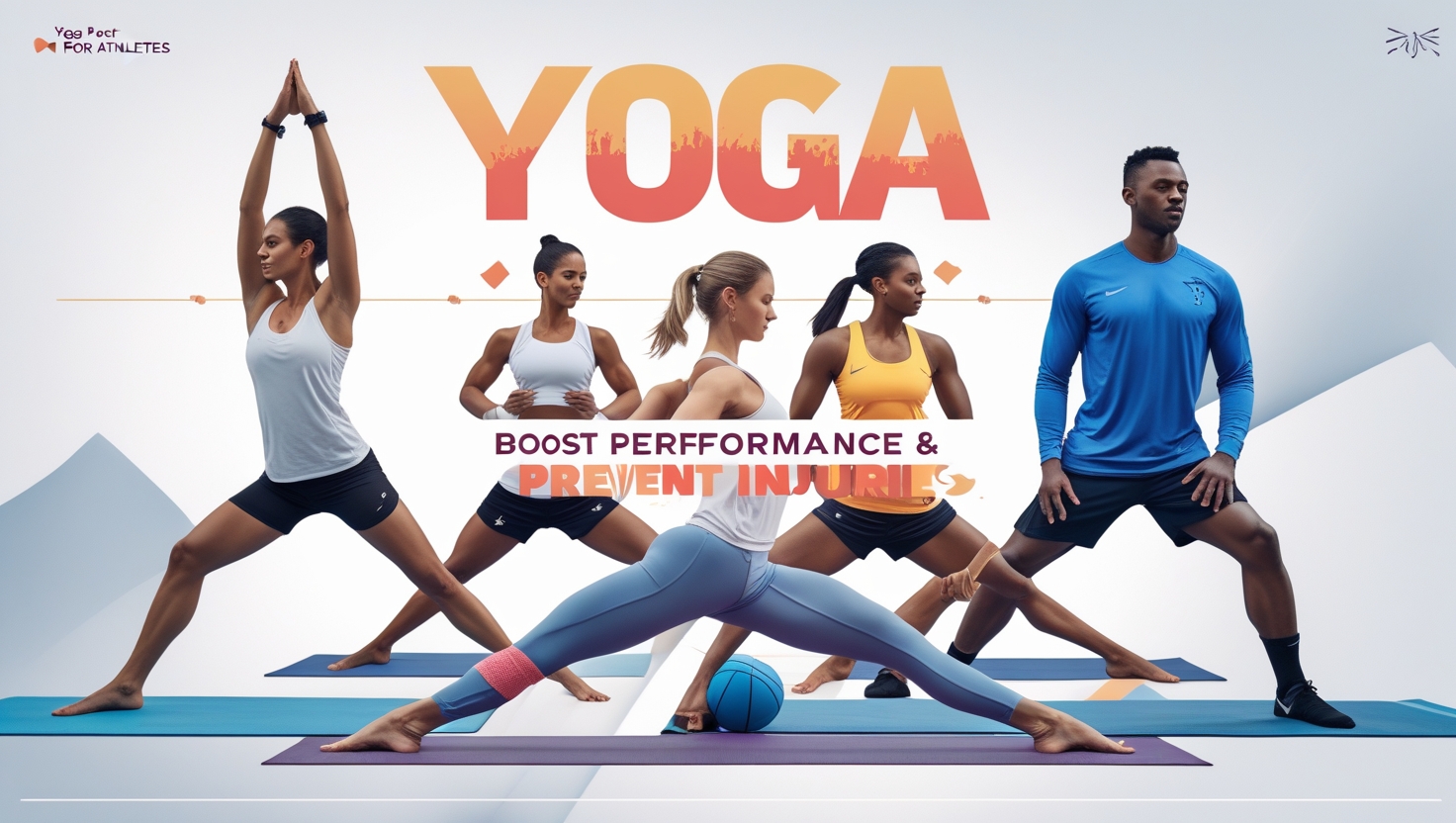Athletes, whether amateur or professional, constantly seek ways to gain a competitive edge while minimizing the risk of injury. Incorporating yoga into an athletic training regimen offers a unique blend of benefits that enhance strength, flexibility, balance, and mental focus. In this comprehensive guide, we delve into how yoga for athletes can boost performance, accelerate recovery, and prevent injuries, ensuring you stay at the top of your game.
Introduction: The Power of Yoga in Athletic Training
In the high-pressure world of sports, every advantage counts. Traditional strength and conditioning routines are essential, but they often overlook the critical elements of flexibility, balance, and mental resilience. Yoga bridges these gaps by offering a holistic approach that not only hones the body’s physical capabilities but also sharpens the mind.
Why Athletes Should Consider Yoga
- Injury Prevention: Yoga improves flexibility and balance, reducing the likelihood of strains, sprains, and overuse injuries.
- Enhanced Recovery: Mindful movement and deep stretching promote faster muscle recovery and alleviate post-workout soreness.
- Improved Performance: Regular yoga practice can boost strength, endurance, and coordination, which are vital for peak performance.
- Mental Clarity: Techniques like mindfulness and breath control reduce stress, enhance concentration, and increase mental resilience.
- Holistic Conditioning: Yoga complements traditional training by addressing both physical and mental aspects, creating a balanced approach to athletic performance.
Integrating yoga into your training isn’t about replacing your current regimen—it’s about enhancing it. Whether you’re looking to improve your flexibility for better range of motion or build core strength to stabilize your movements, yoga offers targeted benefits for every athlete.
Physical Benefits of Yoga for Athletes
1. Increased Flexibility and Range of Motion
Athletes often experience muscle tightness from repetitive movements and intense training. Yoga helps lengthen muscle fibers, increase joint mobility, and reduce stiffness, leading to smoother, more efficient movements on the field or court.
Key Poses:
- Downward-Facing Dog (Adho Mukha Svanasana): Stretches the hamstrings, calves, and spine.
- Pigeon Pose (Eka Pada Rajakapotasana): Opens the hips and relieves tension in the glutes and lower back.
- Seated Forward Bend (Paschimottanasana): Enhances flexibility in the hamstrings and lower back.
2. Enhanced Strength and Stability
Many yoga poses require the body to support its own weight in new ways, building strength in the core, legs, arms, and stabilizing muscles. This not only improves overall athletic performance but also helps prevent injuries by ensuring that all muscle groups are well-balanced.
Key Poses:
- Plank Pose (Phalakasana): Strengthens the core, shoulders, and arms.
- Warrior II (Virabhadrasana II): Builds lower body strength and endurance.
- Chair Pose (Utkatasana): Engages the quadriceps and core, promoting balance and stability.
3. Injury Prevention and Rehabilitation
One of the most significant advantages of incorporating yoga is its ability to prevent injuries by increasing body awareness and correcting imbalances. Regular practice helps identify and address areas of weakness, reducing the risk of overuse injuries and enhancing overall body alignment.
Benefits:
- Balance Training: Poses like Tree Pose (Vrksasana) improve proprioception, which is crucial for avoiding falls and sudden twists.
- Muscle Recovery: Gentle stretching promotes blood flow to sore muscles, facilitating quicker recovery after intense training sessions.
- Core Stability: A strong core supports nearly every movement, reducing strain on the lower back and preventing injuries.
Mental and Emotional Benefits for Athletes
1. Enhanced Focus and Concentration
Yoga emphasizes the connection between breath and movement, training the mind to remain focused on the present moment. This heightened concentration is invaluable during competition, where distractions can compromise performance.
Techniques:
- Mindful Breathing: Practices such as alternate nostril breathing (Nadi Shodhana) help center the mind and improve focus.
- Meditative Poses: Holding a pose like Warrior III (Virabhadrasana III) demands concentration and enhances mental discipline.
2. Stress Reduction and Mental Resilience
The mental demands of sports can be as taxing as the physical ones. Yoga offers effective stress management tools that help athletes remain calm and composed under pressure.
Techniques:
- Guided Meditation: Incorporating meditation sessions into your routine can reduce cortisol levels and improve mood.
- Progressive Muscle Relaxation: This technique helps athletes release tension and recover mentally after strenuous workouts.
3. Improved Recovery and Sleep Quality
Quality rest is essential for peak performance. Yoga’s calming effects extend into sleep, ensuring that athletes get the restorative rest they need to rebuild muscle and energy levels.
Benefits:
- Relaxation Techniques: Poses like Savasana (Corpse Pose) promote deep relaxation, reducing insomnia and enhancing overall sleep quality.
- Mind-Body Connection: A relaxed mind contributes to a faster recovery, making it easier to bounce back from injuries and heavy training sessions.
Dynamic Yoga Sequences for Athletes
Integrating yoga into your training routine can be both dynamic and targeted. Here are a few sequences designed to boost performance and prevent injuries:
Sequence 1: Pre-Workout Warm-Up Flow
Objective: Increase blood flow, warm up muscles, and enhance flexibility.
- Mountain Pose (Tadasana): Stand tall and take a few deep breaths to center yourself.
- Sun Salutations (Surya Namaskar): Perform 5–10 rounds to warm up the entire body.
- Low Lunge (Anjaneyasana): Stretch the hip flexors and prepare the legs for intense activity.
- Downward-Facing Dog (Adho Mukha Svanasana): Engage the shoulders, stretch the hamstrings, and increase circulation.
Sequence 2: Post-Workout Recovery Flow
Objective: Stretch out fatigued muscles, improve circulation, and facilitate recovery.
- Child’s Pose (Balasana): Begin with a gentle stretch to calm the body.
- Pigeon Pose (Eka Pada Rajakapotasana): Deeply stretch the hips and lower back.
- Seated Forward Bend (Paschimottanasana): Release tension in the back and hamstrings.
- Legs-Up-The-Wall Pose (Viparita Karani): Promote blood flow and reduce swelling in the legs.
Sequence 3: Core Strength and Balance Flow
Objective: Build core stability and enhance balance—key components for injury prevention.
- Plank Pose (Phalakasana): Engage the core and strengthen the arms.
- Side Plank (Vasisthasana): Focus on the obliques and improve lateral balance.
- Warrior III (Virabhadrasana III): Enhance balance and core strength with a dynamic standing pose.
- Boat Pose (Navasana): Strengthen the core and improve overall stability.
Sports-Specific Yoga Practices
Different sports demand varying physical attributes. Tailor your yoga practice to address specific needs based on your sport:
For Runners:
- Focus Areas: Hamstring flexibility, hip opening, and lower back strength.
- Recommended Poses: Forward Bend, Pigeon Pose, and Bridge Pose (Setu Bandhasana).
For Cyclists:
- Focus Areas: Lower back and hip flexibility, and quadriceps strength.
- Recommended Poses: Seated Forward Bend, Low Lunge, and Warrior II.
For Strength Athletes:
- Focus Areas: Core stability, upper body strength, and balance.
- Recommended Poses: Plank Pose, Crow Pose (Bakasana), and Chair Pose.
For Team Sports Players:
- Focus Areas: Full-body mobility, balance, and mental focus.
- Recommended Poses: Sun Salutations, Warrior Poses, and Tree Pose.
Incorporating Yoga Into Your Athletic Routine
Establish a Consistent Practice
The key to reaping the benefits of yoga is consistency. Whether you integrate a short 10-minute session daily or a longer practice several times a week, regular yoga will complement your training regimen and enhance overall performance.
Combine with Traditional Training
Yoga should serve as a supplement to your primary training. Use yoga as a warm-up or cool-down activity, or schedule dedicated yoga sessions on off days to aid recovery and maintain balance.
Listen to Your Body
While pushing your limits is part of athletic growth, it’s equally important to recognize when your body needs rest. Use yoga as a tool to listen to your body’s signals, prevent overtraining, and avoid injuries.
Use Guided Resources
Consider joining a yoga class for athletes or using specialized online resources. A certified instructor can provide modifications and ensure your form is correct, maximizing the benefits while minimizing the risk of injury.
Frequently Asked Questions (FAQs)
1. How often should an athlete practice yoga?
For most athletes, integrating yoga 2–3 times per week into their training routine is sufficient. Some may benefit from shorter daily sessions, especially if focusing on recovery and flexibility.
2. Can yoga improve my performance in high-intensity sports?
Absolutely. Yoga enhances flexibility, core strength, balance, and mental focus—all of which are crucial for peak performance in high-intensity sports. It also aids in faster recovery, allowing you to train harder and more effectively.
3. Is yoga effective for injury prevention?
Yes. By improving balance, muscle symmetry, and flexibility, yoga helps prevent common sports injuries such as strains, sprains, and overuse injuries. Its focus on mindful movement also helps athletes correct misalignments that could lead to injury.
4. What types of yoga are best suited for athletes?
Dynamic styles such as Vinyasa and Power Yoga are excellent for building strength and endurance, while restorative yoga is beneficial for recovery. A combination of both can be highly effective, depending on your training goals.
5. How can I integrate yoga into my existing training schedule?
Consider using yoga as a warm-up to increase blood flow before intense workouts or as a cool-down to stretch and relax muscles afterward. Additionally, dedicated yoga sessions on off-days can enhance recovery and overall balance.
6. Will yoga interfere with my strength training?
On the contrary, yoga can complement strength training by enhancing core stability and flexibility. Improved balance and muscle symmetry can lead to better performance in traditional strength exercises.
Conclusion: Elevate Your Athletic Performance with Yoga
Integrating yoga into your athletic training regimen is a game-changer. With benefits ranging from enhanced flexibility and strength to improved mental focus and faster recovery, yoga for athletes offers a holistic approach that can propel your performance to new heights while safeguarding you against injuries.
By adopting tailored yoga routines and incorporating mindful practices into your training schedule, you not only address the physical demands of your sport but also cultivate the mental resilience needed to excel under pressure. Remember, every pose, every breath, and every moment of mindful movement is an investment in your long-term performance and well-being.
Embrace the journey of combining traditional training with the transformative power of yoga. Step onto your mat, focus on each movement, and watch as your body and mind become more aligned, resilient, and ready to face the challenges of competition.
Your journey to peak performance and injury prevention begins with a single mindful breath—integrate yoga, stay consistent, and unlock your full athletic potential.















Add comment